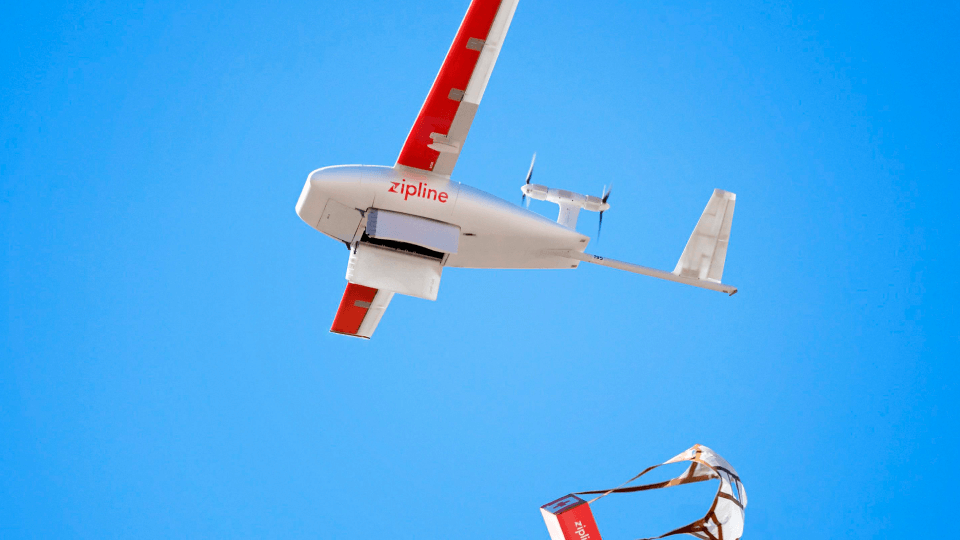Product descriptions:
Zipline is transforming logistics by delivering blood, vaccines and critical medical supplies to healthcare facilities in remote communities — specifically in Ghana and Rwanda — using remote-operated drones. These drones are powered by massive volumes of data which can be difficult to ingest and analyze in a timely manner. Databricks enables Zipline to streamline their data analytics efforts. By giving everyone the resources they need to accurately extract data insights and derive meaning from their findings, they can make smarter decisions about how to improve the performance of Zipline’s drones and increase the efficiency of logistics operations.
Harnessing drone and community data at scale
Every year, thousands of lives are lost around the world because basic medical supplies can’t reach those in need. Zipline is redefining logistics by using cutting-edge drone technology and a global autonomous logistics network to save lives by giving remote communities access to emergency and preparatory medical aid and resources, regardless of where they are in the world.
But while drones are the vehicle for this global medical aid service, the unsung heroes are the data behind the deliveries that makes them safe, reliable, and scalable. Getting that job done successfully requires the ability to ingest and analyze huge chunks of time-series data in real time. This data is produced every time a drone takes flight, and includes performance data, in-flight battery management, regional weather patterns, geographic obstacles, landing errors and a litany of other information that has to be processed.
“A lot of people focus on the airplane,” says Keller Rinaudo, Zipline CEO. “But all our customers really care about is whether something goes from point A to point B fast enough to save someone’s life. We could be using magical dragons as far as they’re concerned, just as long as the job gets done.”
Every Zipline flight generates a gigabyte of data with potential life-or-death consequences, especially if it throws a Zipline drone (or “Zip”) off course. But accessing and federating the data for both internal and external decision making was easier said than done before Databricks, as they didn’t have an efficient way of harnessing and sharing the data across the organization and their supply chain partners.
Zipline’s data team needed a centralized platform that could not only scale compute to support their real-time data needs, but also needed to democratize access to data and insights for various teams to make smarter decisions that could save more lives.
Aiding the underserved with data and ML
With Databricks, Zipline’s data team and their colleagues throughout the company are able to access all of the information they need to accurately measure success, find the metrics that relate to customer experiences or logistics, and improve on them exponentially as more data is ingested and machine learning models are refined. “Within a data-driven culture, it’s important to ensure everyone is able to make decisions with the right data,” explained Matt Fay, the data team lead at Zipline. “Databricks not only helps our data team, but also everyone in the company deliver insights faster.”
Through real-time access to thousands of flights’ worth of data, Zipline’s engineers can quickly write custom analyses in order to figure out what’s going on in the field, determine if issues or failures are occurring, whether or not the problems are localized, and how those various factors could impact operations.
“Databricks empowers us to not only build the tools and utilities necessary to access our data, but others in the organization can easily build visualizations and start extracting actionable insights from the data to solve pressing issues,” said Fay.
Accurate information about drone performance and flight charts helps Zipline make quick choices between replacing or retrieving drones — and how each option affects the healthcare facilities they serve.
“About 30% of the deliveries we do are lifesaving emergency deliveries, where the product being delivered does not exist at the hospital. We have to be fast, and we have to be able to rely on all the different kinds of data to predict failures before they occur, so that we can guarantee a really, really high service level to the people who are literally depending on us with their lives,” said Rinaudo.
Laying the runway for the future of medicine
Diagnosing real-world problems in real time is a welcome advance in healthcare, but it’s become an especially crucial capability in the face of COVID-19. As the world collectively mobilizes to curb the pandemic’s seemingly unstoppable spread, one incredibly important weapon against the virus could be drone delivery.
Zipline is already helping their partners develop and deploy large-scale responses, and could prove vital for delivering eventual vaccines, treatments, and PPE to homes and hospitals — reducing person-to-person contact and bolstering resources in areas where medical supplies are hard to come by.
“We’re working here because we’re saving lives,” says Whitney Huang, Embedded Software Engineer at Zipline. “We’re diagnosing real-world problems in real time, finding anomalies as they happen, and fine-tuning our algorithms so that we become more successful with every flight.”
Traditional supply chains have been so far incapable of adjusting or scaling to support underserved communities. Zipline’s drones and data science-backed supply chain logistics are likely the modern answer to decades of slow, ineffective aid and supply distribution.
“Databricks gives us confidence in our operations, and enables us to continuously improve our technology, expand our impact, and provide lifesaving aid where and when it’s needed, every single day,” concludes Rinaudo.

